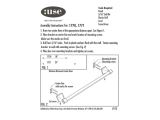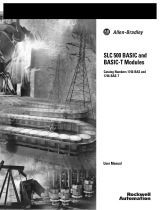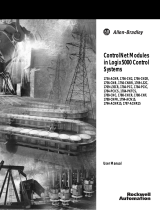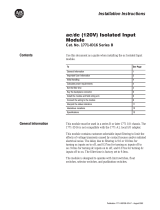Page is loading ...

AC (120V) Isolated Output Module
Cat. No. 1771-OD
Installation Data
This document provides information on:
important pre–installation considerations
power supply requirements
initial handling procedures
installing the module
using the module indicators for troubleshooting
replacing the fuse
module specifications
An output from this module can drive an Allen–Bradley Size 5 motor
starter, provided its supply voltage does not drop below 105V ac. The
maximum load current the module can deliver is 2A per channel, not to
exceed 6A total per module.
The switching device in the output circuit is a triac. There is a small
leakage current in the off state due to both triac and capacitive
characteristics. The maximum leakage current per output is 5mA at
138V ac. Nominal leakage current is 1mA. The on–state voltage drop
across the output terminals is no more than 2.0V ac at 100mA.
The triac needs a minimum of 60mA load current to stay on. If your
device pulls less than 60mA, the triac will not operate. The total
continuous current the module supports is 6A (2A maximum per channel).
If this rating is exceeded, the module overheats and damage may occur.
To The Installer
Pre-installation Considerations

AC (120V) Isolated Output Module
(Cat. No. 1771-OD)
Installation Data
2
Suppression
Surge suppression circuitry is provided for the output triacs of this module.
To suppress high–voltage transients from the ac line, a metal–oxide
varistor (MOV) is provided between each set of terminals on the module.
In each output circuit, an RC network limits the magnitude of voltage
transients that may occur when a device is wired in parallel or series with
hard contacts.
Loads with inductive characteristics may require additional suppression
devices. The impedance characteristic of the load is the most important
factor in selecting a suppression device; thus no single suppression device
can be recommended for every possible load. See Table A for acceptable
suppression devices for typical loads.
Table A
Allen-Bradley
Suppressors
Allen-Bradley Equipment Suppressor Catalog Number
Motor Starter Bulletin 509 599-K04
1
Motor Starter Bulletin 709 1401-N10
1
Relay Bulletin 700 Type N or P 700-N5/700N9
2
Miscellaneous 700-N24
3
1 For starters with 120V ac coils
2 Maximum coil voltage 150V ac or dc
3 Bulletin 700-N24 is a universal surge suppressor. You can use it on electromagnetic
devices with the limitation of 35 sealed VA, 150V.
The isolated output module is powered by the power supply connected to
the I/O chassis backplane. The module requires a maximum current of
225mA from the +5V dc output of this supply. Total the current
requirements of this module with the other modules in the I/O chassis to
avoid overloading the supply or the I/O chassis backplane.
Power Requirements

AC (120V) Isolated Output Module
(Cat. No. 1771-OD)
Installation Data
3
The ac output module is shipped in a static–shielded bag to guard against
electrostatic discharge damage. Observe the following precautions when
handling the module.
ATTENTION: Remove power from the 1771 I/O chassis
backplane and wiring arm before removing or installing an I/O
module.
Failure to remove power form the backplane or wiring arm
could cause module damage, degradation of performance, or
injury.
Failure to remove power from the backplane could cause
injury or equipment damage due to possible unexpected
operation.
Touch a grounded object to rid yourself of charge before handling the
module.
Do not touch the backplane connector or connector pins.
When you configure or replace internal components, do not touch other
circuit components inside the module. If available, use a static–safe
work station.
When not in use, keep the module in its static–shield bag.
In this section we tell you how to key your I/O chassis, install your module
and make your wiring connections
Module Location in the I/O Chassis
Group your modules to minimize adverse effects from radiated electrical
noise and/or heat. We recommend the following.
Group analog input and low voltage dc modules away from ac modules
or high voltage dc modules to minimize electrical noise interference.
Place analog input modules and other I/O modules sensitive to heat
away from slot power supplies to minimize adverse heat effects.
Initial Handling Procedures
Installing
Y
our Module

AC (120V) Isolated Output Module
(Cat. No. 1771-OD)
Installation Data
4
Keying the I/O Chassis
Use the plastic keying bands, shipped with each I/O chassis, to key your
I/O slots to accept only this type of module. Place keying bands between
these numbers labeled on the upper backplane connector:
between 4 and 6
between 30 and 32
Slots on the rear edge of the circuit board are matched to these slots to
allow insertion of the module. You can key any connector in an I/O chassis
to receive this module except for the left–most connector reserved for
adapter or processor modules.
ATTENTION: A module inserted into a wrong slot could be
damaged by improper voltages connected through the wiring
arm. Use keying bands to prevent damage to the module.
Inserting the Module into the Chassis
1. Position the module so that the circuit board on the rear of the module
lines up with the top and bottom card guides in the chassis.
2. Slide the module into the chassis.
3. Press firmly to seat the module in the chassis backplane connector.
4. Swing the module locking latch down into place over the front of the
module.
Connecting Wiring to the module
You make connections to the module through the 1771–WD field wiring
arm shipped with the module. The arm pivots on the chassis to connect
with the 12 terminals on the front of the module (Figure 1). The wiring
arm allows the module to be removed from the chassis without
disconnecting wiring.
1. Make certain all power is removed from the module before making
wiring connections.
2. Swing the wiring arm up into position on the front of the module. The
locking tab on the module will secure it into place.
3. Make your connections to the field wiring arm as shown in Figure 1.
(Use the label on the front of the wiring arm to identify your wiring.)

AC (120V) Isolated Output Module
(Cat. No. 1771-OD)
Installation Data
5
ATTENTION: The field wiring arm terminal identification
number is not the same as the number of the bit which controls
that output.
You should identify the labels on the wiring arm with the name or number
of the device connected at each terminal.
Figure 1
Connection
Diagram for 1771-OD Isolated Output Module
L1
L2
120V ac
Supply
1
2
3
4
5
6
7
8
9
10
11
12
Load
Output 0A
Output 0B
Output 1A
Output 1B
Output 2A
Output 2B
Output 3A
Output 3B
Output 4A
Output 4B
Output 5A
Output 5B
10593-I
You can use an output of the 1771–OD module to drive an input of a 120V
ac input module (1771–IA, –IA2, –ID, –IAD) to indicate status of turning
on a motor starter, for example (Figure 2). However, you must add a 2.5K
ohm, 10W resistor (or an Electrocube snubber, pt. no. RG-1676-1) between
the output and L2 (common). Inputs configured with the output module are
not isolated from each other (except for 1771–IAD inputs).
ATTENTION: Do not connect the 1771–OD output channels
in series. Doing so can result in distortion of the output
waveform causing the output devices to chatter.

AC (120V) Isolated Output Module
(Cat. No. 1771-OD)
Installation Data
6
Figure 2
Driving
an Input with an Output
AC/DC (120V) Input Module
Cat. No. 1771-IAD
A
O
1
2
3
4
5
6
7
8
Input 00
Input 01
Input 02
Input 03
Input 04
Input 05
Input 06
Input 07
Input 10
Input 16
Input 11
Input 12
Input 13
Input 14
Input 15
Input 17
1
2
3
4
5
6
7
8
9
10
11
12
1
2
3
4
5
6
7
8
9
10
11
12
L1 L2
AC (120V) Isolated
Output Module
Cat. No. 1771-OD
AC (120V) Isolated
Output Module
Cat. No. 1771-OD
120V ac
Supply
L1 L2
120V ac
Supply
120V AC Input Module
Cat. No. 1771-IA, -IA2
2K ohm
20 Watt
Resistor
10594-I
2.5K ohm
10 Watt
Resistor
The module has 12 status indicators (Figure 3). The top 6 indicators show
the state of each output and are driven by the logic circuitry on the
programmable controller side of the module. These indicators light when
their corresponding outputs are energized.
The bottom 6 indicators display a blown–fuse condition at the respective
output regardless of the state of the output. These indicators are driven by
your power supply.
Interpreting the Status
Indicators

AC (120V) Isolated Output Module
(Cat. No. 1771-OD)
Installation Data
7
Figure 3
Status
Indicators
Red Output
Indicators
Status
Clear Fuse Blown
Indicators
00
01
02
03
04
05
00
01
02
03
04
05
ISOLATED
AC OUTPUT
10595-I
Replacing a Fuse
Each module output is individually fused. You can easily access the
module fuses by removing the front component–side cover.
ATTENTION: Remove power from the 1771 I/O chassis
backplane and wiring arm before removing or installing an I/O
module.
Failure to remove power from the backplane could cause
injury or equipment damage due to possible unexpected
operation.
Failure to remove power from the backplane or wiring arm
could cause module damage, degradation of performance, or
injury.
If a blown fuse occurs:
1. Turn off power to the I/O chassis backplane.
2. Pivot the wiring arm away from the module and pull the module from
the I/O chassis.
3. Remove the front component side cover from the module by
removing the screws securing the cover to the module.
4. Replace the blown fuse.
5. Replace the protective cover and install the module in the I/O chassis.
6. Reposition the wiring arm.
7. Restart system power.

Specifications
AC (120V) Isolated Output Module
(Cat. No. 1771-OD)
Installation Data
8
Outputs per Module 6
Module Location 1771 I/O Chassis
Voltage Rating 92 to 138V ac @ 47-63 Hz
Output Current Rating (per channel) 2A per output (not to exceed 6A per module)
Surge Current 20A maximum for 100msec
Repeatable every 5 seconds
Minimum Load Current 60mA per output
On-state Voltage Drop 2V ac (max) at 100mA
Off-state Leakage Current 5mA (max) per output at 138V ac
Power Rating 4Watts per output
Power Dissipation 13.2 Watts (max); 1.2 Watts (min)
Thermal Dissipation 45.2 BTU/hr (max); 4.1 BTU/hr (min)
Backplane Current 225mA
Maximum Cable Length 1000 ft (304.8 m)
Isolation Voltage 1000V channel-to-channel
1500V to backplane
Environmental Conditions
Operational Temperature
Storage Temperature
Relative Humidity
0
o
to 60
o
C (32
o
to 140
o
F)
-40
o
to 85
o
C (-40
o
to 185
o
F)
5 to 95% (without condensation)
Conductors Wire Size
Category
14 gage stranded maximum
3/64 inch insulation maximum
1
1
Keying Between 4 and 6
Between 30 and 32
Fuse 5A, 3AG normal blow fuses (1 per output)
Field Wiring Arm Catalog Number 1771-WD
Wiring Arm Screw Torque 79 inchpounds
1
Refer
to publication 1770-4.1, Programmable Controller Wiring and Grounding Guidelines
With offices in major cities worldwide
WORLD
HEADQUARTERS
Allen-Bradley
1201 South Second Street
Milwaukee, WI 53204 USA
Tel: (1) 414 382-2000
Telex: 43 11 016
FAX: (1) 414 382-4444
EUROPE/MIDDLE
EAST/AFRICA
HEADQUARTERS
Allen-Bradley Europe B.V.
Amsterdamseweg 15
1422 AC Uithoorn
The Netherlands
Tel: (31) 2975/43500
Telex: (844) 18042
FAX: (31) 2975/60222
ASIA/PACIFIC
HEADQUARTERS
Allen-Bradley (Hong Kong)
Limited
Room 1006, Block B, Sea
View Estate
28 Watson Road
Hong Kong
Tel: (852) 887-4788
Telex: (780) 64347
FAX: (852) 510-9436
CANADA
HEADQUARTERS
Allen-Bradley Canada
Limited
135 Dundas Street
Cambridge, Ontario N1R
5X1
Canada
Tel: (1) 519 623-1810
FAX: (1) 519 623-8930
LATIN AMERICA
HEADQUARTERS
Allen-Bradley
1201 South Second Street
Milwaukee, WI 53204 USA
Tel: (1) 414 382-2000
Telex: 43 11 016
FAX: (1) 414 382-2400
As a subsidiary of Rockwell International, one of the world’s largest technology
companies — Allen-Bradley meets today’s challenges of industrial automation with over
85 years of practical plant-floor experience. More than 11,000 employees throughout the
world design, manufacture and apply a wide range of control and automation products
and supporting services to help our customers continuously improve quality, productivity
and time to market. These products and services not only control individual machines but
integrate the manufacturing process, while providing access to vital plant floor data that
can be used to support decision-making throughout the enterprise.
Publication 1771–2.12 – April 1992
Supersedes publication 1771–2.12 – April 1990
P/N 955111–51
Copyright 1992 Allen–Bradley Co. Inc. Printed in USA
/







